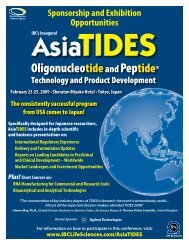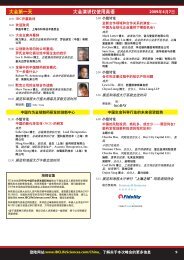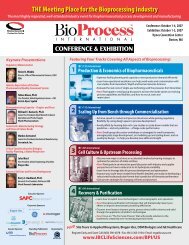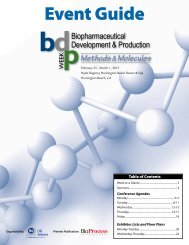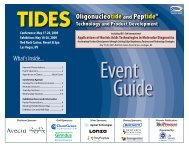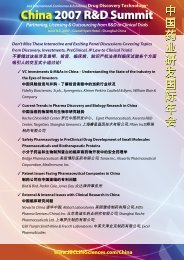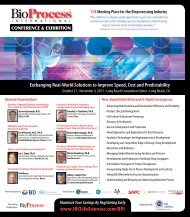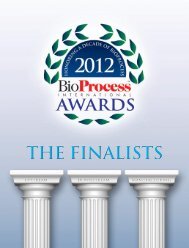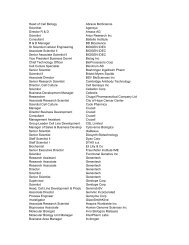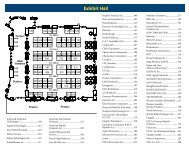Register Early and Save up to $300 (See page ... - IBC Life Sciences
Register Early and Save up to $300 (See page ... - IBC Life Sciences
Register Early and Save up to $300 (See page ... - IBC Life Sciences
You also want an ePaper? Increase the reach of your titles
YUMPU automatically turns print PDFs into web optimized ePapers that Google loves.
Wednesday, September 22, 2010 • Main Conference<br />
7:00 Registration <strong>and</strong> Coffee<br />
7:15 Technology Workshop (Light Continental Breakfast will be served.)<br />
Biological Assays for Characterization of Raw Materials Used in Mammalian Cell Culture Media Formulations<br />
SAFC Biosciences raw materials characterization initiative was established <strong>to</strong> evaluate variability in raw materials used <strong>to</strong> formulate cell culture media <strong>and</strong> thereby improve media consistency <strong>and</strong><br />
performance in cell culture manufacturing processes. Cell-based biological assays were developed <strong>to</strong> investigate the effects of raw materials on cell growth, production <strong>and</strong> product quality. Biological assays were designed <strong>to</strong> include<br />
appropriate indica<strong>to</strong>r cell lines, assay media <strong>and</strong> conditions <strong>to</strong> detect lot-<strong>to</strong>-lot variability among raw material s<strong>up</strong>pliers<br />
Andrew Christie, Principal Scientist, Cell <strong>Sciences</strong> & Development, SAFC Biosciences<br />
Managing Manufacturing Networks<br />
Product <strong>Life</strong>cycle Management<br />
Raw Materials/S<strong>up</strong>ply Chain<br />
The Future of Manufacturing Networks<br />
<strong>and</strong> Facilities<br />
8:00 Chairperson’s Remarks<br />
Alison Moore, Ph.D., Vice President, Corporate Manufacturing,<br />
Amgen Inc.<br />
8:15 CMC-Related Regula<strong>to</strong>ry Considerations for Development<br />
of Antibody-Drug Conjugates: An FDA Perspective<br />
Antibody-drug conjugates (ADCs) are designed <strong>to</strong> deliver a cy<strong>to</strong><strong>to</strong>xic<br />
drug through a targeting moieties (e.g., tumor cells) utilizing the<br />
specificity of a monoclonal antibody. Although such ADCs are simple in<br />
principle, significant chemistry, manufacturing, <strong>and</strong> control (CMC)-<br />
related challenges arise during development <strong>and</strong> regula<strong>to</strong>ry review.<br />
CMC-related issues unique <strong>to</strong> this class of molecules will be discussed.<br />
Jun Park, Ph.D., Regula<strong>to</strong>ry Quality Reviewer, Division of Monoclonal<br />
Antibodies, Office of Biotechnology Products, CDER, US FDA<br />
8:45 Leveraging Innovation <strong>to</strong> Achieve Successful<br />
Strategies for the Biotech Business<br />
Based on a discussion of various elements of strategic uncertainty <strong>to</strong>day,<br />
this talk will look at technology, financial, <strong>and</strong> strategic business aspects that<br />
in combination could form sources for success <strong>to</strong>morrow. We will challenge<br />
the mainstream discussion of manufacturing issues <strong>and</strong> will provide a view<br />
on innovation that goes beyond what R&D alone can deliver.<br />
Günter Jagschies, Ph.D., Senior Direc<strong>to</strong>r, Strategic Cus<strong>to</strong>mer<br />
Relations, GE Healthcare <strong>Life</strong> <strong>Sciences</strong>, Sweden<br />
9:15 New, Unpublished Data<br />
CASE STUDY Development <strong>and</strong> Implementation of<br />
a Next-Generation Manufacturing Process for a New<br />
rFVIII Product<br />
Building on the experience with Bayer’s recombinant Kogenate®<br />
product line, the strategy of the BAY 81-8973 CMC development team<br />
was <strong>to</strong> utilize targeted innovation <strong>to</strong> develop, scale-<strong>up</strong> <strong>and</strong> implement<br />
a new, simplified <strong>and</strong> more efficient <strong>up</strong>stream <strong>and</strong> downstream<br />
manufacturing process. The resulting new technologies now also form<br />
the manufacturing platform for other complex biologics.<br />
Dr. Jens H. Vogel, Global CMC Development Team Leader <strong>and</strong> Head,<br />
Isolation <strong>and</strong> Purification, Bayer Healthcare<br />
9:45 Networking Refreshment Break in Exhibit <strong>and</strong> Poster Hall<br />
Sponsored by<br />
10:30 Subcutaneous Protein Delivery: Challenges,<br />
Opportunities, <strong>and</strong> Key Lessons from a Drug<br />
Delivery Platform<br />
Biotech companies are often spending much effort concentrating<br />
mAbs <strong>to</strong> ≥ 100 mg/mL <strong>to</strong> accommodate subcutaneous dosing at<br />
high doses. Halozyme’s Enhanze Technology permits SC dosing<br />
of much greater than 1 mL/injection, which enables bypassing high<br />
concentration formulation challenges with the potential <strong>to</strong> allow rapid<br />
conversion of intravenous drugs <strong>to</strong> subcutaneous administration,<br />
which may benefit patients’ convenience <strong>and</strong> compliance.<br />
Michael J. LaBarre, Ph.D., Vice President, Product Development,<br />
Halozyme Therapeutics, Inc.<br />
11:00 New, Unpublished Data<br />
CASE STUDY Biodefense: Human Genome <strong>Sciences</strong>’<br />
Development <strong>and</strong> Manufacture of an Antibody for<br />
Treatment of Anthrax Delivered <strong>to</strong> the Strategic<br />
National S<strong>to</strong>ckpile<br />
The anthrax attacks of 2001 reaped fear <strong>and</strong> panic in our nation. In<br />
response President Bush proclaimed "we will rally the great promise<br />
of American science <strong>and</strong> innovation <strong>to</strong> confront the greatest danger<br />
of our time." Eight years later Human Genome <strong>Sciences</strong> delivered<br />
the first doses of raxibacumab <strong>to</strong> the U.S. government. The antibody<br />
program <strong>and</strong> its unique twists <strong>and</strong> turns are chronicled.<br />
Craig Malzahn, Direc<strong>to</strong>r, S<strong>up</strong>ply Chain / Manufacturing Operations,<br />
Human Genome <strong>Sciences</strong>, Inc.<br />
11:30 Upgrading Current Facilities for Future High<br />
Titer Processes<br />
Success in biopharmaceutical manufacturing is increasingly<br />
challenged by new production requirements, aggressive timelines <strong>and</strong><br />
economic drivers. New product platform strategies <strong>and</strong> technologies,<br />
as well as process simulation <strong>to</strong>ols have been incorporated <strong>to</strong> meet<br />
future manufacturing dem<strong>and</strong>s. The new <strong>up</strong>grades will develop facility<br />
flexibility by increasing asset utilization, assist in long term capital<br />
planning of projects <strong>and</strong> coordinate cross site facility consistency.<br />
Rich Meinel, Associate Direc<strong>to</strong>r Global Process Engineering<br />
Technology, Biogen Idec<br />
Continuous Process Improvement<br />
8:00 Co-Chairpersons’ Remarks<br />
Maninder Hora, Ph.D., Vice President, Product Operations,<br />
Facet Biotech<br />
Ellen L. McCormick, Direc<strong>to</strong>r, Bio<strong>Sciences</strong> Gro<strong>up</strong>, Pfizer, Inc.<br />
8:15 New, Unpublished Data<br />
CASE STUDY A Continuously Evolving mAb Process<br />
Over the life cycle of a mAb, drivers such as s<strong>up</strong>ply dem<strong>and</strong>s,<br />
increased process knowledge, new technologies, regula<strong>to</strong>ry st<strong>and</strong>ards<br />
<strong>and</strong> additions <strong>to</strong> manufacturing network all contribute in the decision<br />
<strong>to</strong> make process changes. This case study follows the strategy <strong>and</strong><br />
challenges of a currently approved mAb purification process as it<br />
evolves from its original <strong>to</strong> its current <strong>and</strong> potential future state.<br />
Debbie O’Connor, Scientist, Late Stage Purification, Process R&D,<br />
Genentech, Inc.<br />
8:45 New, Unpublished Data<br />
CASE STUDY Continued Underst<strong>and</strong>ing of<br />
Biopharmaceutical Production Processes Post-Validation<br />
Underst<strong>and</strong>ing of biopharmaceutical production process is a<br />
continuous task performed over the lifecycle of the product. Effective<br />
analysis of manufacturing data allows identification of trends<br />
<strong>and</strong> their potential root cause, as well as potential improvement<br />
opportunities within the design space. Procedures <strong>and</strong> case studies for<br />
effective process moni<strong>to</strong>ring <strong>and</strong> identification <strong>and</strong> implementation of<br />
process <strong>and</strong> technology improvements will be presented.<br />
Ciaran Brady, Ph.D., Associate Direc<strong>to</strong>r, Biopharmaceutical<br />
Development, Human Genome <strong>Sciences</strong> Inc.<br />
9:15 Humira Downstream Process: Challenges in<br />
Continuous Improvement <strong>and</strong> Technical Transfer<br />
Humira (adalimumab) was successfully launched in 2002. Currently, it is<br />
manufactured at 6,000-L <strong>to</strong> 12,000-L scales in different facilities. In the past<br />
years, continuous efforts have been made <strong>to</strong> enhance process robustness,<br />
<strong>to</strong> ensure the consistency of product quality <strong>and</strong> process performance<br />
at different facilities, as well as <strong>to</strong> satisfy <strong>and</strong> harmonize divergent global<br />
regula<strong>to</strong>ry dem<strong>and</strong>s. QbD approaches have been applied <strong>to</strong> the process<br />
optimization with implementing better process control strategies.<br />
Helen Yang, Technical Operations, Abbott Bioresearch Center<br />
9:45 Networking Refreshment Break in Exhibit <strong>and</strong> Poster Hall<br />
Sponsored by<br />
10:30 New, Unpublished Data<br />
CASE STUDY Utilization of QbD Principles for the<br />
Management of Post-Approval Changes<br />
Management of post-approval process changes for biotechnology<br />
products is well suited <strong>to</strong> the application of QbD principles <strong>and</strong><br />
risk-based approaches. Here the application of QbD principles for<br />
the management of post-approval changes is applied <strong>to</strong> s<strong>up</strong>port drug<br />
substance changes intended <strong>to</strong> improve process efficiency, reduce raw<br />
material risks <strong>and</strong> s<strong>up</strong>port scale-<strong>up</strong> <strong>and</strong> process transfer.<br />
Marc Better, Ph.D., Executive Direc<strong>to</strong>r, Process Development, Amgen Inc.<br />
11:00 New, Unpublished Data<br />
CASE STUDY Advanced Process Control <strong>and</strong> Real-<br />
Time Chroma<strong>to</strong>graphy Moni<strong>to</strong>ring<br />
Liquid chroma<strong>to</strong>graphy plays an important role in the purification<br />
of pharmaceutical products derived from biotechnology processes.<br />
Process-scale separations often involve multiple column operations,<br />
each consisting of multiple phases so column packing, qualification <strong>and</strong><br />
process moni<strong>to</strong>ring are important areas of concern. This presentation<br />
discusses Biogen Idec’s strategy for chroma<strong>to</strong>graphy analysis <strong>and</strong><br />
moni<strong>to</strong>ring. This approach leverages the power of multivariate analysis,<br />
advanced analytical algorithms, <strong>and</strong> process knowledge <strong>to</strong> achieve the<br />
enhance process underst<strong>and</strong>ing <strong>and</strong> improved process performance.<br />
Robert Genduso, Scientist II, Biogen Idec<br />
11:30 New, Unpublished Data<br />
Design of a Contamination Barrier for Serum-<br />
Containing Cell Culture Media of a Licensed Product<br />
Despite their infrequency, microbial, viral <strong>and</strong> mycoplasma<br />
contaminations of biomanufacturing facilities have had significant<br />
financial, production <strong>and</strong> regula<strong>to</strong>ry impacts <strong>to</strong> companies.<br />
Robustness of the contamination barrier depends on the degree<br />
of inactivation/clearance conferred by treatment technologies <strong>and</strong><br />
the risk of raw materials. HTST, UVC, viral filtration <strong>and</strong> gamma<br />
irradiation, as well as raw material decomposition strategies, were<br />
evaluated <strong>to</strong> overcome impact <strong>to</strong> process/product.<br />
R. Michael Boychyn, Ph.D., Principal Engineer, Amgen Colorado<br />
Process Development, Amgen Inc.<br />
12:00 Concurrent Technology Workshops<br />
Point Counterpoint Session:<br />
Integrating Raw Materials <strong>and</strong> S<strong>up</strong>pliers<br />
in<strong>to</strong> a Pharmaceutical Quality System<br />
8:00 Co-Chairpersons’ Remarks:<br />
Duncan Low, Ph.D., Scientific Executive Direc<strong>to</strong>r, Process<br />
Development, Amgen, Inc.<br />
Wolfgang Noe, Ph.D., Vice President, Bioprocess Development,<br />
Biogen Idec<br />
8:05 Risk Assessment <strong>and</strong> Management for Raw Materials<br />
A holistic risk assessment approach is described, including<br />
s<strong>up</strong>plier capabilities, quality systems, <strong>and</strong> material safety data.<br />
In addition, an assessment of material properties on the process,<br />
which links parameters <strong>to</strong> critical quality attributes, is required. The<br />
information required is significant but the outputs can result in a<br />
clearer prioritization of the data required, more rational setting of<br />
specifications, avoidance of redundant testing <strong>and</strong> a better foundation<br />
for continuous improvement.<br />
Duncan Low, Ph.D., Scientific Executive Direc<strong>to</strong>r, Process<br />
Development, Amgen, Inc.<br />
8:30 S<strong>up</strong>ply Chain Risk Management Methodologies<br />
Using case studies, this talk will demonstrate the usefulness of<br />
applying an analytical driven sourcing methodology <strong>to</strong> mitigate risks<br />
within a company's s<strong>up</strong>ply chain. In addition, this talk will address<br />
Biogen Idec's approach <strong>to</strong> ensure objectives of assurance of product<br />
s<strong>up</strong>ply, product quality <strong>and</strong> financial compliance within the s<strong>up</strong>ply<br />
chain through a instituting a decentralized GMP sourcing model.<br />
Issues like organizational approaches, governance structures, sourcing<br />
<strong>to</strong>ols <strong>and</strong> risk management techniques will be discussed.<br />
Joydeep Ganguly, Associate Direc<strong>to</strong>r, Manufacturing <strong>Sciences</strong>, Biogen Idec<br />
8:55 Global Adventitious Agent Regulations of Raw<br />
Materials Used in Biopharmaceutical Manufacturing<br />
Abstract unavailable at press date. Please visit<br />
www.<strong>IBC</strong><strong>Life</strong><strong>Sciences</strong>.com/BPI for program <strong>up</strong>dates.<br />
Barbara Potts, Ph.D., Senior Consultant, Biologics Consulting<br />
Gro<strong>up</strong>, Inc.<br />
Co-author: T.W. Tanaka<br />
9:20 New, Unpublished Data<br />
CASE STUDY S<strong>up</strong>plier Perspective on Risk Assessment<br />
<strong>and</strong> Management of Critical Raw Materials for the<br />
Manufacture of Biological Therapeutics<br />
The pharmaceutical market is requiring greater characterization <strong>and</strong><br />
transparency of the s<strong>up</strong>ply chain for critical raw materials used in<br />
manufacturing due <strong>to</strong> the continuing need <strong>to</strong> minimize variability<br />
<strong>and</strong> increased regula<strong>to</strong>ry oversight. This presentation will focus<br />
on techniques for characterization <strong>and</strong> a case study on how these<br />
techniques improved our underst<strong>and</strong>ing of the solubility of these<br />
components <strong>to</strong> enhance the consistency of the manufacturing process.<br />
David Kolwyck, Technical Manager, SAFC, a division of Sigma Aldrich<br />
9:45 Networking Refreshment Break in Exhibit <strong>and</strong> Poster Hall<br />
Sponsored by<br />
10:30 Implementing a Raw Materials/S<strong>up</strong>plier Management<br />
Risk Mitigation Strategy with Limited Resources<br />
• What do you do after you assess the risks<br />
• What can you use <strong>to</strong> compensate for identified risks-- short term<br />
<strong>and</strong> long term<br />
• Tactics for small firms<br />
• Leveraging information<br />
Paula Shadle, Ph.D., Principal Consultant, Shadle Consulting Services<br />
10:55 New Applications of Analytical Methodologies for<br />
Raw Material Characterization<br />
Abstract not available at press date. Please visit<br />
www.<strong>IBC</strong><strong>Life</strong><strong>Sciences</strong>.com/BPI for program <strong>up</strong>dates.<br />
Maureen Lanan, Ph.D., Principal Scientist, Analytical Development,<br />
Biogen Idec<br />
11:20 Audience Interactive Panel Discussion with<br />
All Session Presenters<br />
Achieving Reproducible Manufacturing Outcomes through<br />
the Use of Scale-down Models<br />
The use of accurate scale down modeling ensures that lab data represent the manufacturing<br />
case when transferring bioprocesses between sites. Diosynth has used a lab scale fermentation model <strong>to</strong> accurately<br />
reflect manufacturing operations, leading <strong>to</strong> successful scaling of five microbial processes over the last two years.<br />
Discussion will center <strong>up</strong>on how <strong>and</strong> when <strong>to</strong> use scale-down models <strong>to</strong> achieve reliable manufacturing results.<br />
Raghu Shivappa, Ph.D., Fermentation Team Leader, Upstream Process Development, Diosynth Biotechnology<br />
Stewart McNaull, Ph.D., Section Leader, Upstream Process Development, Diosynth Biotechnology<br />
Relieving Bottlenecks in Downstream Purification:<br />
Further Advances in Membrane Chroma<strong>to</strong>graphy <br />
Part 1: Dr. Carl Law<strong>to</strong>n will present his recent work on scaling <strong>up</strong> purification of E. coli<br />
expressed proteins using single step capture <strong>and</strong> clarification.<br />
Carl W. Law<strong>to</strong>n, Ph.D. Associate Professor, Biological Engineering Program Coordina<strong>to</strong>r, Direc<strong>to</strong>r, Massachusetts<br />
BioManufacturing Center (MBMC)<br />
Part 2: Novel Chemistries for High-Capacity / High-Throughput Single-Use Membrane Chroma<strong>to</strong>graphy<br />
C Howie Honeyman, Ph.D., Vice President, Research <strong>and</strong> Product Development, Natrix Separations Inc.<br />
Fully Disposable, Multiple mAb Processing for Clinical Trials<br />
A step-by-step review of a typical mAb platform process from inoculation <strong>to</strong> final filtration<br />
will provide solutions for single- or campaign-use technology as well as technical <strong>and</strong><br />
economical criteria <strong>to</strong> decide what the best alternative would be: a classic equipment set<strong>up</strong> or<br />
the disposable option.<br />
Jonathan Royce, Category Leader Bioprocess, GE Healthcare <strong>Life</strong> <strong>Sciences</strong><br />
12:30 Networking Lunch in Exhibit <strong>and</strong> Poster Hall with Dedicated Poster Viewing<br />
Poster presenters are requested <strong>to</strong> st<strong>and</strong> by their posters for discussion.<br />
CelliGen BLU: How New Brunswick has Combined the Performance<br />
of Stirred Tank Technology with the Benefits of Single-Use<br />
The CelliGen BLU is New Brunswick’s newest offering in the bench<strong>to</strong>p bioreac<strong>to</strong>r <strong>and</strong> fermen<strong>to</strong>r family of products.<br />
Positioned as a novel system offering 5.0L or 14.0L stirred tank single-use vessels; this system mimics traditional<br />
au<strong>to</strong>clavable technology while providing all the benefits of disposable technology. The CelliGen BLU will meet the dem<strong>and</strong>s<br />
of the single-use system users not satisfied with the current bench scale single-use bioreac<strong>to</strong>rs available on the market.<br />
Richard Mirro, Product Manager, New Brunswick Scientific<br />
7 To <strong>Register</strong>, Call: (800) 390-4078 • Fax: (941) 365-0104 • E-mail: reg@ibcusa.com





